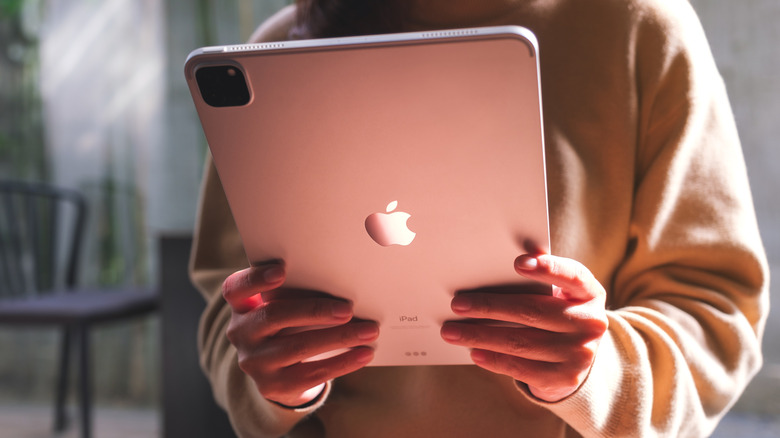
Like the iPhone, Apple's iPad has become so ubiquitous over the years that many industries use it to carry out organized and shared activities. But how is this possible, knowing the iPad is primarily designed to be a single-user device? Unlike a Mac or Windows device, the Cupertino giant's tablet does not have multi-user functionality, wherein users are free to switch accounts on a single device without overlapping activity and data use. Copying and pasting from one Apple device to another is possible through
workarounds like the Universal Clipboard, but having a distinct profile for each user is more efficient, especially when other features are needed for use.
To make it possible for multiple users to share an iPad, Apple has come up with mobile device management tools that provide a different kind of shared usage. For business and educational environments, iPads can be set up as Shared iPads through the Managed Apple Accounts feature, which allows users to have personalized and secure access to the same physical device, complete with their own user data, apps, and settings. For families, Apple's Family Sharing feature allows family members to share purchases, subscriptions, and other services all from a single Apple ID group. Thus, while the iPad is a single-user device, it can accommodate multiple users via shared experiences within the iPadOS operating system, albeit not in a way that can replace a laptop's multi-user capabilities.
Read more: 7 Of The Most Useful USB Gadgets You Can Buy On Amazon
Shared iPad For Business

In corporate or professional settings, iPads are handy for synchronizing work and making it easy for managers to view everyone's activities. To allow different employees to use the same iPad with their own login credentials and user data, the devices can be set up as a Shared iPad via Apple Business Manager. When enabled, the Shared iPad feature allows employees to access the accounts created for them and controlled by their organization via Managed Apple Accounts.
When an employee logs in through Managed Apple Accounts, the iPad loads their apps, documents, and settings, just like a personal device would. This makes it easy for different employees working different shifts to share the same iPad without compromising privacy or productivity. However, it's important to note that not all iPads can be set up as a Shared iPad. Only those with at least 32GB of storage and running iPadOS can be used for this purpose; fortunately, it's easy to tell which iPad model you have.
Meanwhile, if business owners prefer their employees not to leave any tracks of their use, they can rely on guest login via the temporary session feature to do the job. This allows employees to use the iPad as guests, so they don't need to log in. All of their data will also be erased once their session ends.
Shared iPad For Education

Educators can utilize the Shared iPad function to manage their students' digital activities and allow multiple students to share a single tablet without compromising their personal settings and data. However, instead of Apple Business Manager, schools must set up the tablets using Apple School Manager. This way, when students log into a Shared iPad, Managed Apple Accounts will load their specific data, including apps, settings, and even browser bookmarks.
Apple School Manager allows teachers to assign apps and books to Shared iPads remotely. Since everything is automatically saved to the iCloud, students can sign in to any of their school's Shared iPads and pick up right where they left off on their schoolwork or reading. This makes the feature particularly useful in schools that don't have a one-to-one device-to-student ratio.
The Classroom app offers another way for instructors to take control of their classes using the iPad. Available for both iPad and Mac devices, this tool helps teachers guide students through lessons, lock them into specific apps during tests, and monitor their progress in real time. It even has an in-app feature that lets teachers take control of nearby classes that are unmanaged.
Finally, educators may also turn to a temporary session to grant students temporary access to a shared iPad. However, do note that students using the tablet through this mode wouldn't be able to view purchased books, which require personal Apple accounts or access via Managed Apple Accounts.
iPad For Family Sharing

For families who want to build a shared system with their iPads, where every family member can join, they don't need to use Shared iPad, Managed Apple Accounts or any of the two Manager features. Apple has a feature called Family Sharing, which allows up to six members to share purchases, subscriptions, and other services while keeping individual Apple IDs private. One adult in the group acts as the organizer and is in charge of setting everything up and inviting members.
With Family Sharing, every family member can use and share things like iCloud storage, Apple Music, App Store purchases, and even their locations for easy tracking. For families with young children, the feature lets the organizer set up accounts with parental controls to implement screen time limits, screen purchases, and other iPad tricks parents need to know to improve or regulate their children's tablet use. Family Sharing is also accessible through the iPhone, so parents may keep tabs on their kids without bringing their iPad around.
Overall, while Family Sharing does not let users switch between full user profiles and physically share devices, like in Shared iPad applications in school and professional settings, it offers a practical and privacy-conscious way for parents or guardians to take control over their children's tablet use and digital footprint within a shared group.
Want the latest in tech and auto trends? Subscribe to our free newsletter for the latest headlines, expert guides, and how-to tips, one email at a time.
Read the original article on SlashGear.











